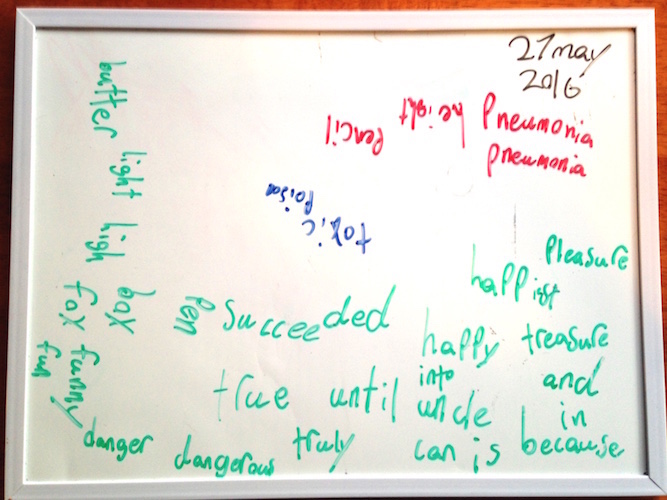
This Shore Crab specimen was found under one of many rocks at the Darwin Walk near my home. I found the creatures, and directed all the photos in this report. (3)
CONTENTS.
Tasmania's European Shore Crabs.
Penguin Design.
Word Games.
Chemistry Experiments.
Human DNA.
Victorian Gold Rush Hatred.
Models of Chemical Molecules.
A Science Project About Tasmania's European Shore Crabs.
Observations and Report. March - April 2017.
This project is about the European Shore Crab found at Darwin Walk. The scientific name of the European Shore Crab is Carcinus maenas.
My Changing Aims For This Project. My original aim was to research the Surf Crab but there was a difficulty finding them at Darwin Walk. So sadly I had to give up and research the European Shore Crab.
1. Photos and Labels of the Shore Crab by J.

This Shore Crab specimen was found under one of many rocks at the Darwin Walk near my home. I found the creatures, and directed all the photos in this report. (3)
What is the real size of the crabs in the photos? My estimate is that the crab shell (above) is 3-4 cm wide and 2-2.5 cm long.
2a. Facts About the Crabs.
What Main Crab Species Did I Discover? The main crab species I discovered were the Carcinus maenas (European Shore Crab) and an unidentified crab species. (6)
When Did Crabs Appear in Evolution's Geological Record? Crabs appeared in the Jurassic time period, 200 million years ago. (7)
What do Shore Crabs Eat? Shore Crabs eat algae, other crabs, sea slugs and mussels.
What Animals Hunt and Eat the Crab? Sharks, people and shore birds all hunt and eat crabs.
2b. Facts About the Original Place of the Shore Crabs.
When, Where and How Did This Species Populate Tasmania? These crabs came from Europe in the 1700s-1800s on boats.
Is This Crab a Native Tasmanian Species or an Invasive Species? The European Shore Crab is an invasive species.
Where are crabs placed in Evolution's Tree of Life? Crabs are arthropods (jointed foot), and crustaceans (crust).
3. My Own Field Observations.
Time of My Observations. I started observing and collecting marine life in 2015. I started this Project on the 23-3-17.
Environment of My Observations.


My observation was that low tide was best to find crabs and high tide was a bad time to look for crabs. The weather was cold a lot at the Darwin Walk. The tide pools were not clean most of the time. Crabs need half-clean water to live. If the water was too clean they wouldn't have food to eat because they need seaweed to live.
Chemical Elements in the Crab Environment.
Crabs inhale oxygen (O2 ) and exhale carbon dioxide (C O2). Crabs live in salt water. Sea salt is sodium chloride (Na Cl). Crabs live in sand, which is silicon dioxide (Si O2). The crab shell is made of calcium carbonate (Ca C O3). The crab's muscles need amines (N H2) in DNA to live. Muscles need sugar (C6 H12 O6) to work. (4)
Method - What I Did - To Observe the Live Crabs.

I went to Darwin Walk and looked under damp rocks.
Describing a Shore Crab - Sizes, Colours, Patterns, Anatomy, Parts.

The crab in this photo is dead. It has big claws and three broken legs. It is a male. It is purple.
How Do You Tell the Sex of a Crab? How do the Sexes Differ?


The sex of a crab depends on the belly. The shape says if it is male or female. Above: If the belly is long and skinny it is male (left) and if the belly is long and wide it is female (right).
How the Crabs Moved. The crabs moved ferociously and silently. The crabs ran fast and hide under rocks.
Other crab species I found.


These two species I found are a sea weed crab (left) and a surf crab (right, above).

What Other Plants and Animals Live In The Crab's Biome?

The rock pools had many life forms: sea slugs, shark eggs and soft crabs (above).
Future Research - What Couldn't I Observe About the Life Of These Crabs? Can crabs make noise? Crab noise is future research.
4a. Primary Research Sources - My Own Research.
(1) My field observations in the rock pools below Darwin Walk.
(2) My own collection of marine skeletons.
(3) Photographs I directed in the field; and photos of my marine collection.
(4) My science word database.
4b. Secondary Research Sources.
(5) qm.qld.gov.au
(6) https://www.sanbi.org/creature/european-shore-crab
(7) http://www.softschools.com/facts/animals/crab_facts/127/
(8) australianmuseum.net.au


Word Games.

CHEMISTRY EXPERIMENTS 2016.
Human DNA.
Victorian Gold Rush and Racists' Rebellion.
"In Bendigo, in 1854, where 2,000 Chinese were digging among a group of 15,000 miners, agitators suggested that a mass action take place on American Independence Day 'for the purpose of driving the Chinese population off the Bendigo goldfields.' ... the Independent Californian Rangers Rifle Brigade, about 200 strong ... was involved in organising military drill prior to the miners' revolt over license fees, that culminated in the battle at the Eureka Stockade at the end of 1854."
Reference: Marilyn Lake and Henry Reynolds, Drawing the Global Colour Line (Melbourne University Press 2008) p.18.
American Independence Day is 4 July (in 1854 Bendigo).
Electronic percussion.
1robert com photos copyright 2017, 2016
![]()
![]()
![]() DeoxyriboNucleic Acid
DeoxyriboNucleic Acid
![]()

![]()








